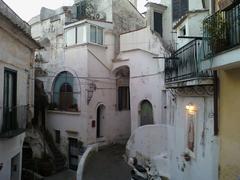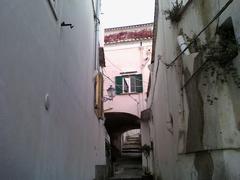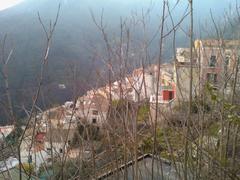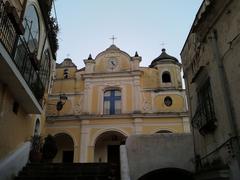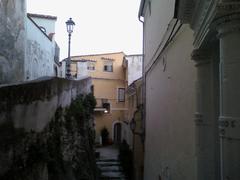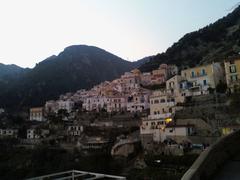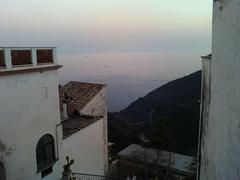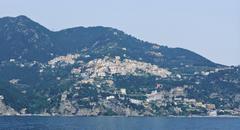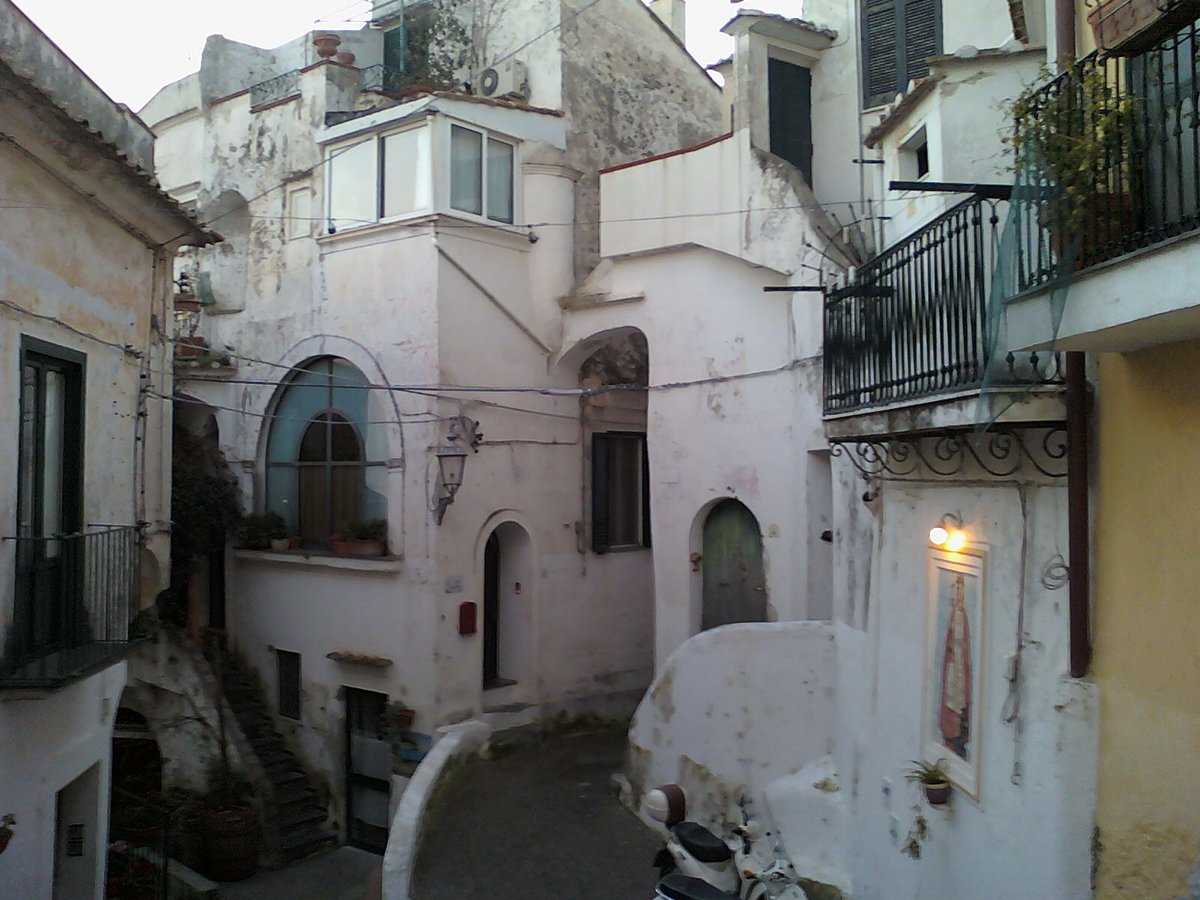
Albori Vietri Sul Mare Italy: Visiting Hours, Tickets, and Historical Sites Guide
Date: 14/06/2025
Introduction to Albori Vietri Sul Mare
Nestled along the breathtaking Amalfi Coast, the hamlet of Albori in Vietri sul Mare stands as a captivating destination for travelers seeking an authentic blend of history, culture, and artisanal heritage. Recognized as one of “I Borghi più belli d’Italia” (The Most Beautiful Villages of Italy), Albori enchants visitors with its vivid pastel-colored houses, labyrinthine cobbled streets, and panoramic views of the Gulf of Salerno. Historically rooted in maritime and agricultural traditions, the village is renowned for its centuries-old ceramic artistry, vibrant festivals, and local cuisine. Albori’s unique setting above Vietri sul Mare also provides easy access to natural attractions like Spiaggia di Albori and renowned hiking trails such as the Sentiero dei Limoni.
This guide provides detailed information on visiting hours, ticketing, accessibility, transportation, key historical and cultural landmarks, local gastronomy, and sustainable tourism practices. Whether you are an art lover, history enthusiast, or culinary explorer, Albori offers an intimate and enriching Italian experience.
For current updates and travel planning, consult Authentic Amalfi Coast Tourism and SoloSophie.
Contents
- Introduction
- History of Albori
- Visitor Information
- Visiting Hours and Tickets
- Getting to Albori
- Accessibility
- Guided Tours and Travel Tips
- Cultural and Artistic Heritage
- Architecture
- Ceramic Tradition
- Festivals and Local Life
- Gastronomy
- Sustainable Tourism
- Nearby Attractions
- Frequently Asked Questions (FAQ)
- Conclusion and Planning Resources
- Official Sources and Further Reading
History of Albori
The name Albori likely derives from the Latin “arbor” (tree), reflecting its historic ties to the surrounding landscape and centuries-old timber trade for shipbuilding. Historically, Albori’s residents balanced their lives between agriculture and seafaring, cultivating the terraced hillsides in winter and navigating the seas during warmer months. This dual heritage shaped the village’s traditions, architecture, and way of life, resulting in a harmonious blend of Mediterranean influences.
Visitor Information
Visiting Hours and Tickets
- Albori Village: Open-access, no entrance fee, accessible at all hours.
- Church of Santa Margherita di Antiochia: Typically open 9:00 AM–6:00 PM daily. Check locally or with the tourist office for seasonal changes.
- Museum of Vietrese Ceramics (in Villa Guariglia, Raito nearby):
- Open Tuesday–Sunday, 10:00 AM–6:00 PM; closed Mondays.
- Tickets: €5 adults, €3 EU citizens 18–25, free for children under 18.
- Historical Documentation Center of the Salernitan Medical School: By appointment only; contact in advance.
Getting to Albori
- By Public Transport: Take a train or bus to Vietri sul Mare from Salerno, then a local bus, taxi, or a scenic uphill walk (approx. 2 km) to Albori.
- By Car: Limited parking; public transport or early arrival recommended.
- On Foot: The area is pedestrian-friendly but features steep, cobbled streets and stairs.
Accessibility
Due to Albori’s historic and mountainous terrain, accessibility for those with mobility impairments is limited. Comfortable walking shoes are strongly recommended.
Guided Tours and Travel Tips
- Guided tours covering Albori and nearby Raito are available and highlight local history, flora, and crafts.
- Visit in spring or early autumn for mild weather and fewer crowds.
- Reserve accommodation and restaurants in advance during peak seasons.
Cultural and Artistic Heritage
Architecture
Albori’s stone and lime houses, bright Neapolitan tile roofs, and pastel facades are a living showcase of Mediterranean architecture. Sailors historically painted their homes in vivid colors for easy identification from the sea. The 16th-century Church of Santa Margherita di Antiochia anchors the village, featuring frescoes by the Neapolitan school and baroque decorations attributed to Francesco Solimena.
Ceramic Tradition
Albori is an integral part of Vietri sul Mare’s famed ceramic legacy. Majolica tiles with vivid polychrome glazes and Islamic-inspired motifs adorn homes, public spaces, and religious sites. The Museo della Ceramica at Villa Guariglia (nearby Raito) displays ceramics from the 18th–20th centuries, including influences from Jewish artists who enriched local styles during the interwar period.
Festivals and Local Life
- Festa Patronale di Santa Margherita (July 20): Religious procession, communal feasts, and music.
- Albori Estate (summer): Musical performances and open-air celebrations.
- Presepe Vivente (Christmas): Living nativity scenes involving much of the community.
These events preserve traditions through music, food, and collective participation.
Gastronomy
Local cuisine emphasizes fresh, seasonal ingredients sourced from nearby farms and the sea. Specialties include penne “alla cuppitiello,” lemon-infused fish, potato croquettes, and regional wines. Dining in Albori offers a direct connection to the village’s agricultural roots and convivial spirit.
Sustainable Tourism
Albori encourages sustainability through pedestrian-friendly infrastructure, eco-walks to Monte Falerio and Cesare spring, and support for local businesses and crafts. Responsible tourism helps maintain the village’s natural beauty and cultural legacy for future generations.
Nearby Attractions
- Vietri sul Mare’s Historic Center: Renowned for ceramic-covered buildings and the Church of San Giovanni Battista.
- Spiaggia di Albori (Albori Beach): Accessible by foot; tranquil beach ideal for relaxation.
- Sentiero dei Limoni (Path of the Lemons): 3 km scenic trail through lemon groves.
- Villa Guariglia: Art and ceramics museum with panoramic gardens.
- Other Hamlets: Raito, Benincasa, Molina, and Dragonea, each with unique charm.
Frequently Asked Questions (FAQ)
Q: What are Albori’s visiting hours?
A: The village is open to visitors at all times. Key sites like the Church of Santa Margherita di Antiochia are usually open from 9:00 AM to 6:00 PM.
Q: Are tickets required for historical sites?
A: Most village sites are free, but museums such as the Museum of Vietrese Ceramics and Villa Guariglia require tickets (€5–€7).
Q: How do I get to Albori from Vietri sul Mare?
A: Albori is about 2 km uphill from Vietri sul Mare, reachable by local bus, taxi, or on foot.
Q: Is Albori family-friendly?
A: Yes, but parents should be mindful of the cobbled streets and stairs for young children.
Q: Is Albori accessible for those with limited mobility?
A: Due to steep, narrow pathways, accessibility is limited.
Conclusion and Planning Resources
Albori is a vibrant, living museum of Mediterranean culture, offering visitors an immersive experience of history, art, festivals, and cuisine. To fully enjoy your visit, consider guided tours, participate in local festivals, and support sustainable tourism. For interactive maps and updates, download the Audiala app. Explore our related articles on Vietri sul Mare, Amalfi Coast travel, and regional gastronomy for more inspiration.
Experience Albori not just as a destination, but as a welcoming community eager to share its traditions and beauty.
Visuals and Media Suggestions
- Include high-quality images: “Albori village street view,” “Ceramics of Albori,” “Festa Patronale di Santa Margherita procession.”
- Use descriptive alt text for all images, e.g., “Panoramic view of Albori from above.”
- Embed an interactive map connecting Albori, Vietri sul Mare, and nearby attractions.
Official Sources and Further Reading
- Authentic Amalfi Coast Tourism
- SoloSophie: Vietri sul Mare Guide
- Travelmar: Vietri sul Mare Travel Guide
- The Tourist Checklist: Things to Do in Vietri sul Mare
- Life in Italy: Vietri sul Mare
- Visit Beautiful Italy: Vietri sul Mare Restaurants
- JouJou Travels: Vietri sul Mare
